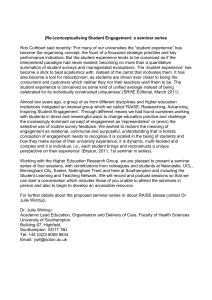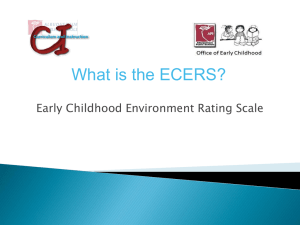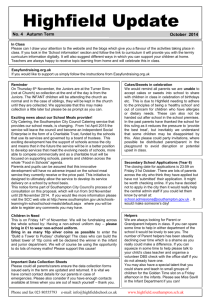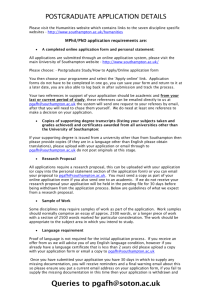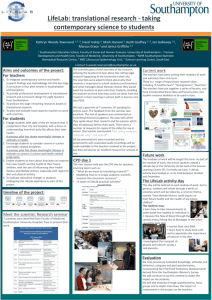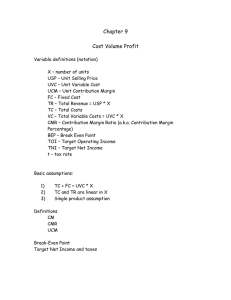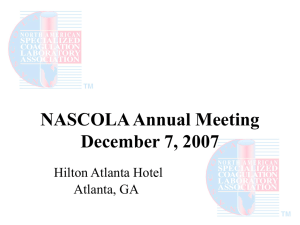Communication & Language Rich Learning
advertisement
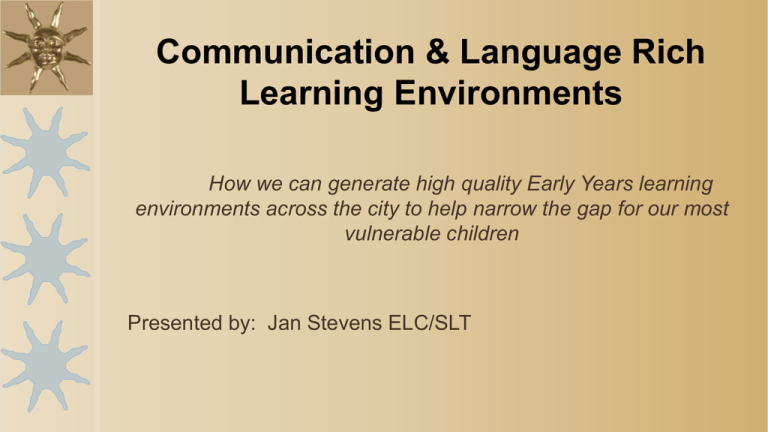
Communication & Language Rich Learning Environments How we can generate high quality Early Years learning environments across the city to help narrow the gap for our most vulnerable children Presented by: Jan Stevens ELC/SLT FIND A FRIEND! Feedback How did that make you feel? Was the activity successful? What made it difficult for you? How could things have been improved? Why Are You Here? To enable you to create & maintain a Language Rich Learning Environment to be able to support ALL children in high quality universal provision Communication Rich Learning Environment Specialist Targeted Universal Agenda Evidence Base Sharing the audit tools currently available in Southampton for Schools & Early Years staff What makes an effective language-rich learning environment? Physical space Planning vocabulary Quality interactions between adults & children Evidence Base Around 10% of all children have SLCN which may be specific or complex & long-term (ICAN Talk Series Issue 2 2006) Up to 50% of children from areas of social-economic deprivation start school with transient language difficulties which may impact on their learning in school if not addressed (Bercow Review 2007) Low income children lag behind their high income counterparts at school entry by 16 months in vocabulary. The gap in language is much larger than gaps in other cognitive skills (Waldfogel & Washbrook 2010) After controlling for a range of other factors, children who had normal nonverbal skills but poor vocabulary at age 5, are at age 34 almost twice as likely to have mental health problems or to be unemployed than children who had normally developing language at 5 (Law et al 2010) The Situation in Southampton Large numbers of children in Southampton have had poor early experiences of communication/positive relationships with caring adults/models of language use Early language learning is contingent on experiences which adults provide … Children who have early language experiences in homes/settings where the quantity & quality of language use is poor are highly likely to have impoverished vocabulary development These children are more likely to struggle with literacy skills in school Does Your Learning Environment …?? 1. 2. 3. 4. 5. 6. 7. Encourage independence & self-confidence? Support children in planning & making choices? Ensure that language learning opportunities are relevant to the children because they occur in meaningful contexts? Provide opportunities to develop Shared Sustained Thinking episodes between adult/child? Offer opportunities for children to interact with others or be alone? Encourage a balance between action & calm, noise & quiet? Celebrate through documentation & display, the learning that is taking place? WHEN WAS THE LAST TIME YOU CRITICALLY OBSERVED THE ENVIRONMENT THAT THE CHILDREN SPEND TIME IN? [OFSTED EARLY YEARS INSPECTION HANDBOOK] Elizabeth Jarman Communication Friendly Spaces www.elizabethjarmanltd.co.uk An APPROACH that can be used to benefit children in all key stages & to support transition into KS1 & KS 2 Considers impact of PHYSICAL & EMOTIONAL environment on communication & language skills Audit Toolkit Communication Supporting Classrooms Observation Checklist (CSC) – available to download from: www.thecommunicationtrust.org.uk ECaT Environmental Audits: Enabling Environment/ Learning & Development/ Positive Relationships Locally developed ECERs/ITERs/FCCERs checklists o EYFS mapping for ECERs/ITERs/FCCERs helps to identify specific targets Communication Supporting Classrooms This tool considers 3 parameters: Physical Environment Structured/Planned Language Learning Opportunities Adult Interaction Styles Physical Space Taken from: Communication Friendly Spaces – Elizabeth Jarman Noise Lighting Colour Clutter Texture ECaT Audit Tool: Enabling Environments CSC Observation Tool: Language Learning Environment (Parameter 1) Structured Language Learning Opportunities Holistic approach: combination of individual/small group work/whole class reinforcement: importance of opportunities for GENERALISATION Planning vocabulary: books/topics/themes/early words for EAL Dialogic book sharing: strategy that turns story sharing into a language learning opportunity by planning vocabulary & open-ended questions (Small-scale research project in Sussex) ECaT Audit Tools: Learning & Development & Positive Relationships CSC Observation Tool: Language Learning Opportunities (Parameter 2) Why Plan Vocabulary? Impoverished early experiences: language/activities/ interactions: Why talk to babies? Vocabulary learning should be ACTIVE planned process supported by exposure to modelling by adults & generous use of visual support Often children may need to hear new words 200 times to generate a clear accurate template before then saying word Adults need to differentiate vocabulary chosen to match current skill levels of all children (EAL children) Planning process should facilitate adults to reflect on own language & choice of words Encourages planning of groups/activities to support generalisation Processing Model LEXICAL REPRESENTATIONS/ PROCESSING INPUT OUTPUT Vocabulary Activity Each Plan group has specific topic for a specific activity on this topic Identify WHICH 10 words you want YOUR children to learn Working on Vocabulary Sort words into these categories: CORE KEY EXTENSION Refer to Language for Literacy Word Web (Nutbrown & Hannon 2011) Language Learning Interactions How do adults in the setting talk with children? Do all adults consistently use ALL Top Tips for Talking with ALL children? Are adults able to adapt their own interaction style to suit the communication & language levels of individual children? How do adults use questions when interacting with children in their setting/classroom? ECaT Audit Tool: Positive Relationships CSC Observation Tool: Language Learning Interactions (Parameter 3) Thinking about Interactions Interactions can be verbal or non-verbal Meaningful interactions should be at least 4 turns Interactions should be well-supported by signs/gestures Good quality interactions depend on wide range of adult interaction styles/strategies Observation Activity DVD Clip 1: Sticking DVD Clip 2: Blocks Watch both clips Complete observation tally chart for each clip What do you notice? 10 Top Tips for Adults Adult uses child’s name to draw attention Adult gets down to child’s physical level Adult uses some natural gestures & signing Adult uses some real objects, photos, symbols to teach new words 5. Adult uses slow pace during conversations 6. Adult pauses expectantly & frequently during conversations 7. Adult confirms understanding of child’s intentions 8. Adult imitates what child says (more or less = recasting) 9. Adult comments on what child is doing 10. Adult extends on what child has said adding extra information 1. 2. 3. 4. How can you achieve high quality interactions consistently? ECaT Positive Relationships Audit: looks principally at QUANTITY of meaningful adult/child interactions (also ECERs checklists) Communication Supporting Classrooms Checklist (3rd parameter): looks at QUALITY of adult interactions (also ECERs checklists) Remember it’s the ADULTS who can make changes to their interaction styles not the children How are we supporting High Quality Universal provision Across Southampton? ECaT in preschool settings: termly Clubs/twilight training/whole staff Universal level Phase 2/whole staff introduction to signing/catch-up sessions From September: roll-out of Narrative groups in settings [evidence-based intervention] Universal level whole staff training for FS teams Universal level training for Foster Carers/Child Minders (termly Clubs for Child Minders too) Narrowing the Gap: Strand specific % AT RISK OF DELAY from total cohort tracked 2014-2015 November 2014 June 15 Listening & Attention 23% 18% Social Communication Skills 29% 24% Understanding 23 % 21% Talking 31% 28% Narrowing the Gap: EYFSP Results 2013-2015 WEST CLUSTER 2013: 55.4% NORTH CLUSTER 2013: 53.4% 2014: 2014: 65.1% 2015: 63.7% 2015: 69.6% 65.5% SOUTH CLUSTER 2013: 47.5% EAST CLUSTER 2013: 47.5% 2014: 2014: 60.4% 2015: 62.7% 57.7% 2015: 66% Good Level of Development Results: 2013: National = 51% Southampton = 50% 2014: National = 60.3% Southampton = 61.8% 2015: National = 66.2% Southampton = 66%

